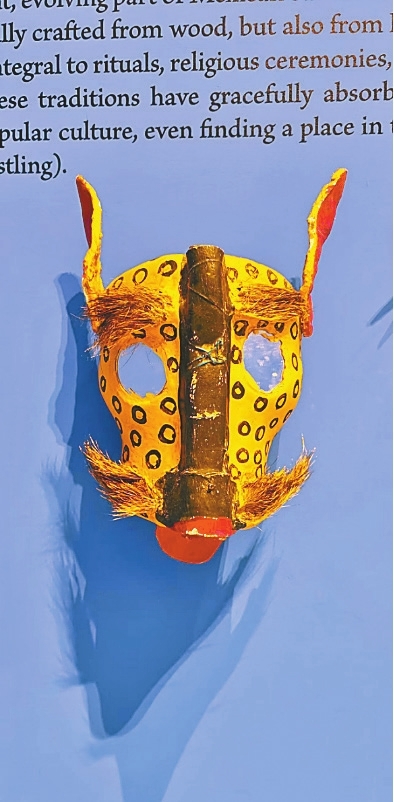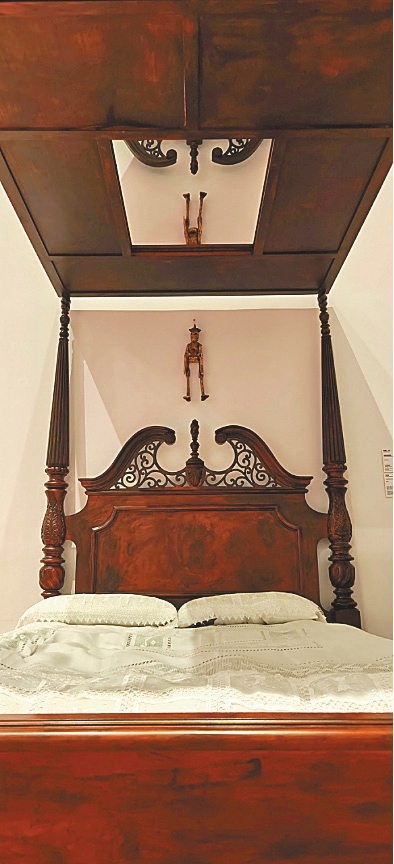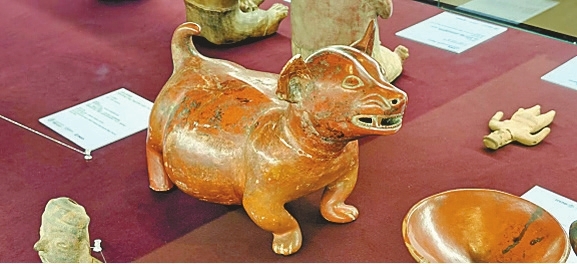
A brightly painted Mexican jaguar mask.

Frida Kahlo's four-post bed.

A terracotta, dog-like "Badger-shaped Vessel" from the 6th-10th century Mexico, part of Frida's collection of artifacts.

A large yellow wall inside the exhibition with a quote from Frida Kahlo in both Chinese and English: "Nothing is absolute. Everything changes, everything moves, everything revolves, everything flies and goes away."
When one thinks of Shenzhen, the mind immediately conjures images of shimmering skyscrapers, cutting-edge technology, and the relentless hum of progress. It is a city of the future, a place that rarely seems to look back. So, you can imagine my astonishment when I learned that one of the 20th century's most iconic and intensely personal artists, Frida Kahlo, was the subject of a major exhibition right here in Shekou. It felt like a delightful glitch in the matrix, a collision of worlds I had to see for myself.
The Sea World Culture and Arts Center, a stunning piece of architecture in its own right, is the unlikely host for “Frida's Paradox,” the first-ever exhibition of the Mexican artist's original works in China. Stepping inside, I was immediately struck by the deliberate and powerful use of color. This was no sterile, white-walled gallery. The entrance explodes in a vibrant, sun-drenched yellow, a color synonymous with Kahlo's beloved Mexico.
Emblazoned on the wall, a quote from the artist sets the tone for the entire experience: "Nothing is absolute. Everything changes, everything moves, everything revolves, everything flies and goes away." It's a profound welcome, inviting you to look beyond the static image of the artist — the unibrow, the flowers in her hair, the Stoic gaze — and into the turbulent, ever-moving world of her inner life.
The exhibition masterfully avoids focusing solely on her most famous self-portraits. Instead, it weaves a narrative of her life through a deeply personal collection of over 250 items, including original oil paintings, sketches, and, most poignantly, her personal belongings. It delves into the profound physical and emotional pain that shaped her, stemming from a devastating bus accident in her youth. Nowhere is this more powerfully felt than in the haunting recreation of her bedroom.
Seeing her four-post bed, with its specially rigged mirror on the canopy that allowed her to paint herself while convalescing, is a moment of hushed reverence. It transforms her from a celebrated artist into a human being of incredible resilience. This was not just a bed; it was her studio, her world, and her prison. It was from this vantage point that she turned her broken body into a canvas, translating her suffering into immortal art.
But the exhibition is equally a celebration of Kahlo's profound connection to her Mexican heritage. It was her armor and her inspiration. The displays showcase a collection of traditional Tehuana dresses similar to those she wore, their intricate embroidery and bold colors a defiant statement of identity. Alongside them are fascinating pre-Columbian artifacts that she and her husband, Diego Rivera, collected, giving visitors a glimpse into the ancient cultural wellspring from which she drew.
These ancient pieces, like the charmingly stout badger-shaped vessel, are displayed with the same care as her paintings. They are presented not as mere relics, but as active participants in her creative universe. They ground her work in a history that is deep, mystical, and uniquely Mexican — a stark contrast to the dominant European art movements of her time.
What makes "Frida's Paradox" a uniquely Shenzhen experience is that the exhibition doesn't end with Kahlo's death but opens a dialogue across time and continents. Interspersed throughout are works by seven contemporary Chinese female artists, each creating pieces inspired by Kahlo's life, spirit, and creative space. It's a brilliant curatorial choice that prevents the show from being a static historical display, instead connecting Kahlo's themes of identity, pain, and resilience to the present day.
Leaving the gallery and stepping back out into the gleaming, modern waterfront of Sea World, I felt the beautiful paradox of it all. Here, in one of the world's newest and fastest-growing cities, the intensely personal, pain-filled, and passionate world of a woman who died decades ago felt incredibly alive and relevant. It is a testament to the growing cultural ambition of Shenzhen, a city that is proving it is as capable of housing the soul of the past as it is of building a vision of the future.






